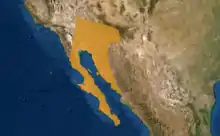Gilded flicker
The gilded flicker (Colaptes chrysoides) is a large-sized woodpecker (mean length of 29 cm (11 in)) of the Sonoran, Yuma, and eastern Colorado Desert regions of the southwestern United States and northwestern Mexico, including all of Baja California, except the extreme northwestern region. Golden-yellow underwings distinguish the gilded flicker from the northern flicker found within the same region, which has red underwings.
| Gilded flicker | |
|---|---|
_on_top_of_cactus.jpg.webp) | |
| Scientific classification | |
| Kingdom: | Animalia |
| Phylum: | Chordata |
| Class: | Aves |
| Order: | Piciformes |
| Family: | Picidae |
| Genus: | Colaptes |
| Species: | C. chrysoides |
| Binomial name | |
| Colaptes chrysoides (Malherbe, 1845) | |
 | |
| Range of the gilded flicker | |
Taxonomy
Four subspecies are recognized:
- The Cape gilded flicker (C. c. chrysoides) resides in southern Baja California.
- The brown gilded flicker (C. c. brunnescens) resides in northern and central Baja California.
- Mearns' gilded flicker (C. c. mearnsi) resides in extreme southeastern California to Arizona and northwestern Mexico.
- The Mexican gilded flicker (C. c. tenebrosus) resides in northwestern Mexico from northern Sonora to northern Sinaloa.
Habitat
The gilded flicker most frequently builds its nest hole in a saguaro cactus, excavating a nest hole nearer to the top than to the ground.[2] The cactus defends itself against water loss into the cavity of the nesting hole by secreting sap that hardens into a waterproof structure that is known as a saguaro boot.[3] Northern flickers, on the other hand, nest in riparian trees and very rarely inhabit saguaros. Gilded flickers occasionally hybridize with northern flickers in the narrow zones where their ranges and habitats overlap.
References
- BirdLife International (2012). "Colaptes chrysoides". IUCN Red List of Threatened Species. 2012. Retrieved 26 November 2013.CS1 maint: ref=harv (link)
- "Gilded Flicker". National Audubon Society. Archived from the original on 2007-12-03. Retrieved 2011-01-24.
Much of the Gilded Flicker's breeding biology needs study. Nesting begins in early April in the United States, and pair bonds appear to last for the breeding season.
- Mark Elbroch; Eleanor Marie Marks; C. Diane Boretos (2001). Bird tracks and sign. Stackpole Books. p. 311. ISBN 0-8117-2696-7.
Cavities in saguaros are cut out by these birds the year before they are inhabited. The excavated cactus secretes a fluid that hardens into a scab, thus preventing water loss, which could kill the cactus, as well as waterproofing the inside of the next cavity.
Gallery
_in_flight.jpg.webp) In flight
In flight_by_nest_hole_in_saguaro_cactus.jpg.webp) By nest hole in saguaro cactus
By nest hole in saguaro cactus
Further reading
External links
| Wikimedia Commons has media related to Colaptes chrysoides. |
- Gilded flicker photo gallery VIREO
- Photo-High Res; Article borderland-tours
- Photo-High Res; Article tsuru-bird.net
